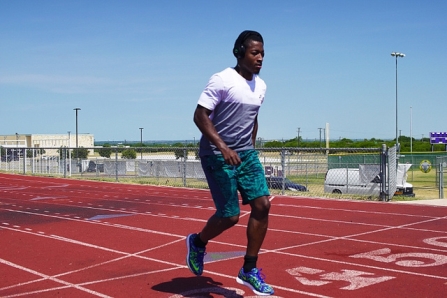Will Rio athletes trade their Halo for medals?
Will Rio athletes trade their Halo for medals?

The 2016 Olympic Games in Rio bring not only teams of highly trained athletes but also bags full of wearable technology which aims to monitor the health and physicality of athletics as they prepare for peak performance.
In these latest Games, we see sports psychology usurped by neuroscience that is designed to maximize the power of the mind. One company working hard in this space is Halo Neuroscience.
I’ve had the pleasure to interview the CEO previously after their pre-sales sold out within their first week of availability. So I was keen to speak to Olympic athletes and coaches that are using Halo Sport in preparation for the 2016 Olympics.
Meet the Halo Sport

Halo Neuroscience has created a a headset called Halo Sport. It resembles a pair of headphones and uses what it call neuro-priming – another term for transcranial direct current stimulation. This involves the use of electrical pulses to encourage the brain to form new pathways to increase performance. When paired with rigorous athletic training, athletes see improved strength, explosiveness, and skill. The United States Olympic Ski and Snowboard Association saw a 1.7X increase in performance when training with Halo Sport.
The athletes using the device in preparation for the Rio Olympics include Michael Tinsley, a 400m hurdler who won silver at the 2012 Olympics in London; Mike Rodgers, who runs 100m sprints and will compete for gold on the relay team; Mikel Thomas, a hurdler from Trinidad & Tobago who is competing in his third Olympics; Hafsatu Kamara, a female sprinter from Sierra Leone who is competing in her first Olympics and Samantha Achterberg, a modern pentathlete from the United States who won gold at the 2012 U.S. Nationals.

Mike Rodgers
Rodgers discussed his experience using this tech:
“As an Olympian, I spend countless hours working out—both in the gym and on the track. Before Halo, I hadn’t seen a comprehensive solution to prepare the brain these for high-performance athletic activities. With Halo, I’m excited to get closer to my potential and reach an even higher level of athletic excellence.” – Mike Rodgers, USA, 400m sprint
Kamara claims a definite increase in strength:
“I’ve been an athlete long enough to know when I have more strength and power, and I can definitely say that Halo Sport has helped me improve in those areas. During resistance training for example, I usually do weighted hip thrusts at 100 kg — after using Halo, I can now train at 120 kg and I feel like my training is pushing me in top form.” – Hafsatu Kamara, Sierra Leone, 100 & 200m sprint
I was wondering about what their coaches’ perspectives would be. Darryl Woodson, USA Track & Field Coach noted:
“Before I was introduced to Halo Sport, I was always fascinated about how to improve the brain’s role in athletic performance. Every athlete knows the importance of training the mind, whether through visualization, watching film, or maintaining focus, but I was interested in how to improve the communication between the brain and muscles. Now that I’ve used Halo Sport with my athletes, I’m amazed that the brain has such a huge impact on performance. Integrating Halo Neurotechnology into my workouts transforms our training.”
It’s clear that wearables are a key tool in maximizing physical potential in physical endeavors. It’s foreseeable that in the future wearables will be permitted as acceptable sportswear whilst competing. How this is managed and policed with be complicated, particularly in individual sports.
But for these games, Halo Sport is not the only wearable inhabiting this space, whoever partners with a medal winner has the potential to bring their wearable device to the masses.
The post Will Rio athletes trade their Halo for medals? appeared first on ReadWrite.
(30)













